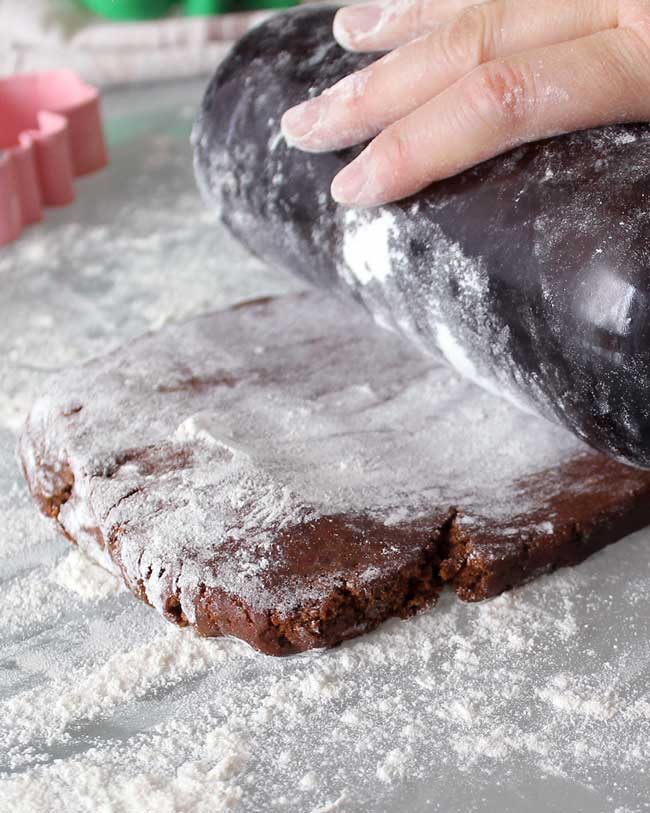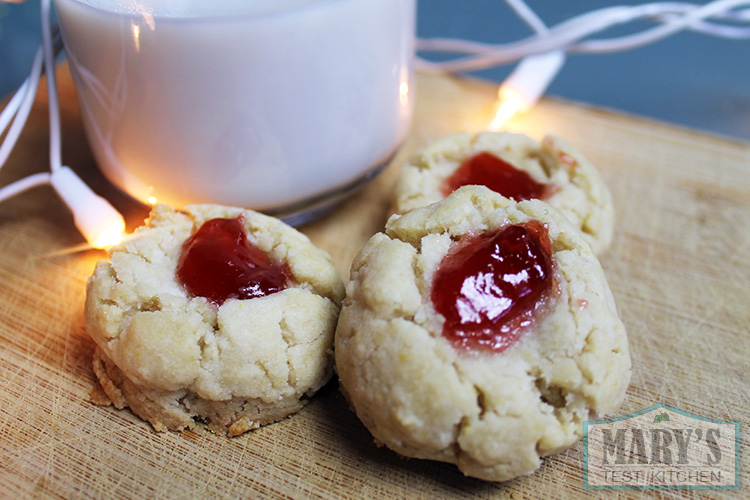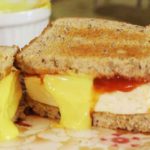These vegan gingerbread men are so easy to make with common ingredients you’ll find in your pantry. Wonderfully spiced and easy to roll out, you can cut them into the classic gingerbread people shapes or use whatever cutters you have on hand. They’re icebox cookies so you’ll refrigerate the dough overnight to firm it up before rolling them out. Feel free to make the cookie dough up to three days in advance.
Skip to the recipe.
Pin this recipe.
Video tutorial for Vegan Gingerbread Men Cookies Recipe
Vegan Gingerbread Cookie Ingredients
Classic gingerbread cookies are mostly plant-based with the exception of eggs and butter. You can easily substitute vegan butter in place of dairy-based butter. My favourite vegan butter for this recipe is Earth Balance Buttery Sticks because it tastes like and really behaves like dairy butter would.
Egg Replacers
Eggs are used as a binder, helping the ingredients stick together and making the dough pliable. Luckily, there are many vegan egg alternatives you can use. For baking cookies, I usually use flax “eggs”. That’s one tablespoon of ground flax mixed with three tablespoons of water. When left to sit for a few minute, the flax and water combo turns into a gel-like consistency that is perfect in place of eggs in vegan baking. However, when I filmed this gingerbread cookie recipe, I had neglected to check my flax seed stores! Whoops. Enter aquafaba.
Aquafaba is becoming more and more common in vegan baking. While you may not have heard of the name, you most likely have it in the pantry somewhere. It’s the liquid from a can of chickpeas or white beans. Three tablespoons of this vicous liquid can replace one egg in many baking recipes. It can even be used for making vegan meringue to top pies or make meringue cookies! It can have a beany scent but the spices in gingerbread will easily cover it up. For aquafaba with minimal beany smell, try making homemade aquafaba yourself!

Don’t be afraid to use plenty of flour to prevent sticking when rolling out this gingerbread cookie dough. You can always brush off the excess later. Dusting the cookie cutters with flour with also help.
Vegan Icing for Gingerbread Cookies
Vegan icing for gingerbread cookies has to be easy to pipe on to the cookies, stay in place and dry completely. The most basic icing can be made with just icing sugar and water or plant-based milk. I add some corn syrup make it easier to pipe smoothly. Plus vanilla extract for flavour but it’s really optional. My recipe makes more than enough icing but it’s easier to handle when you have plenty in the piping bag.
Speaking of piping bags, I used a disposable bag in the video but I couldn’t find the right sized tip. So I used packing tape to reinforce the tip before snipping off the smallest bit to let the icing through. You can do the same thing with a resealable freezer bag if you don’t have piping bags. I kept the icing plain white which stands out beautifully against the molasses brown cookies but you can add vegan food colouring for a bit more fun.

Printable recipe for Vegan Gingerbread Men Cookies Recipe
Vegan Gingerbread Men Cookies Recipe

These vegan gingerbread men are so easy to make with common ingredients you'll find in your pantry. Wonderfully spiced and easy to roll out, you can cut them into the classic gingerbread people shapes or use whatever cutters you have on hand.
Ingredients
Dry Ingredients
- 3 cups flour (360g), plus more for rolling
- 1 1/2 teaspoon baking powder
- 1 tablespoon ginger
- 2 teaspoons cinnamon
- 1/4 teaspoon cloves
- 1/2 teaspoon nutmeg
- 1/4 teaspoon salt
Wet Ingredients
- 1/2 cup vegan butter, room temperature
- 3/4 cup packed brown sugar
- 1/2 cup fancy/light molasses
- 6 tablespoons aquafaba (liquid from can of chickpeas/white beans) or equivalent 2x vegan egg alternative
- 1 teaspoon vanilla extract
Decorating Icing
- 1 tablespoon plant-based milk or water
- 1 tablespoon corn syrup
- 1 1/2 cup icing sugar
- 1/4 teaspoon vanilla extract
Instructions
Make the vegan gingerbread dough:
- In one bowl, sift together flour, baking powder, ground ginger, cinnamon, nutmeg, cloves and salt. In a separate bowl, beat vegan butter and brown sugar together until fluffy. Beat in molasses and aquafaba (or your choice of vegan egg alternative) until smooth.
- Add the dry ingredients to the wet mixture and mix completely until the dough forms. A stand mixer would be great to use for this sticky dough.
- When the dough is smooth, wrap it in plastic wrap and transfer to the fridge. Chill the dough completely (4 hours minimum, ideally overnight). The dough can stay in the fridge up to 3 days.
Roll out the dough, cut and bake
- Take out any junk from your oven and preheat to 350°F. Dust your clean work surface generously with flour. Dust the dough/rolling pin with flour as needed to prevent sticking. Unwrap the dough and roll out to 1/4" thickness. I like to roll out just half the dough at a time to make things easier and so the dough doesn't warm up too much.
- Flour your cookie cutter(s) and cut out as many cookies as you can. Transfer the cookies to two parchment-lined baking sheets. Ball up the excess dough and place into the plastic wrap so you can chill it in the fridge while this batch bakes.
- Brush off any excess flour from the cookies before baking at 350°F for 8 to 10 minutes. 8 minutes for softer cookies with crisp edges; 10 minutes for firmer cookies.
- Let the cookies sit on the baking sheets for a few minutes before transferring to a cookie rack to cool completely before icing. Repeat with the remaining dough.
Icing the cookies
- In a bowl, combine 1 tablespoon of plant based milk or water (hint: using plant-based milk is better), 1 tablespoon corn syrup, and, optionally, 1/4 teaspoon of vanilla extract. Mix together until the corn syrup has completely disappeared into the milk or water.
- Add 1 1/2 cups of icing sugar and stir until the sugar has completely melted into the mixture. If it is not smooth, add one more teaspoon of plant-based milk/water and stir until it is completely incorporated. Add one to two additional teaspoons of liquid if necessary but try not to add too much. The icing should be smooth but quite thick. You can test it by drizzling a bit onto a surface and seeing if it keeps its shape.
- Transfer to a piping bag with a small tip and decorate your cookies to your heart's desire! The icing will set in about an hour but may take a while longer to completely harden.
Storage
Store the cookies in an airtight container or freezer bag. They are best eaten fresh (within a day or two) but can keep for a couple weeks. Enjoy!
Notes
These are icebox cookies so you'll refrigerate the dough overnight to firm it up before rolling them out. Feel free to make the cookie dough up to three days in advance.
This recipe makes about 28 - 36 cookies depending on the size of your cutter.
Vegan butter: I used Earth Balance Buttery Sticks. They are hard like dairy butter and behave similarly. If you use a softer vegan butter/margarine, the dough may be a bit softer and more difficult to roll and cut.
Vegan Egg: I used aquafaba which is the liquid drained from a can of chickpeas or white beans. Flax egg is also a great "vegan egg". For flax egg, combine 2 tablespoons of ground flax with 6 tablespoons of water and let it sit about 5 minutes or until gel-like. Ground chia seed will also work in the same way.
Molasses: I used fancy molasses which has a nice flavour but is not too strong. You can alternatively use corn syrup if you don't like the taste of molasses.
Nutrition Information:
Yield:
28Serving Size:
1Amount Per Serving: Calories: 142Total Fat: 4gSaturated Fat: 2gTrans Fat: 0gUnsaturated Fat: 1gCholesterol: 11mgSodium: 77mgCarbohydrates: 26gFiber: 0gSugar: 16gProtein: 2g
Nutritional Information automatically calculated by a plugin and may not be correct.

For more vegan cookie recipes, check out my super easy Strawberry Thumbprint Cookies, Peanut Butter Snickerdoodles and DIY vegan graham crackers!

These strawberry thumbprint cookies are super delicious with a hint of lemon zest. Click here for the recipe.
What other cookies should I veganize next?



Can I make them with gluten free flour? They look fab!!!
I haven’t tested with gluten-free flour but it should be fine with an all purpose gluten free mix. Please let me know if you try it. Good luck!
-Mary
Hi Mary ! Do you think that blackstrap molasses would be an ok substitute for the fancy molasses ?
Hi Kristena,
Blackstrap molasses has a stronger and more bitter flavour but if you like it, go for it 🙂
Cheers,
Mary
Hi Mary,
Great recipe! just wondering why you use baking powder as most recipes call for baking soda.
Chloe.
Hi Chloe,
For a tender gingerbread cookie with a little bit of lift, use baking powder. Baking soda does not have leavening properties on its own but creates a bit of lift when combined with the more traditional ingredient of eggs. Some recipes use both baking powder and baking soda since can help make cookies crispier. I use baking soda when making gingersnaps and thin gingerbread cookies with a harder texture.
Cheers,
Mary
I just put a batch of this dough in the fridge. I ended up having to add about 1/4 cup water after following the recipe. For an egg replacer, I used the Bob’s Red Mill option. Also, I used measuring cups, not a kitchen scale.
Hi how would you alter this recipe for black strap molasses?
Sorry, I haven’t tested this recipe with black strap molasses. It’s quite strong tasting compared to fancy or light mollasses so I can imagine you can try just using less and then making up for the volume with corn syrup.
Hope that helps!
-Mary